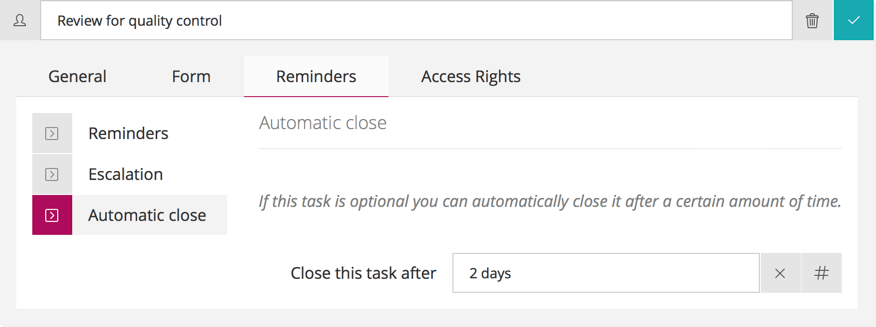When you manage risk and compliance in an organisation, you can use workflow automation to automatically schedule internal controls. As part of an internal control system, a risk manager may choose to review selected control tasks, to help ensure that employees perform controls effectively. This article shows how you can use Signavio Process Governance to automatically schedule these quality control reviews.
Internal controls process
An internal controls process adds systematic quality checks to an organisation’s internal business processes. These controls consist of quality control tasks, typically linked to risk management activities. The purpose of the control tasks is to check for occurrences of identified risks, and other quality issues.
For example, consider a simple employee request process, such as a vacation request.

This is an approval process, in which a manager reviews an employee request according to some policy, and approves or rejects the request. Extending this simple example, suppose the organisation has identified the risk that vacation requests are always approved, leading to staff shortages for supporting a critical business process.
When this happens, despite a vacation policy intended to prevent this, internal controls could help ensure the ‘quality’ of the vacation request approval process, by adding tasks to check that the approving manager applied the policy correctly.
Quality control reviews
One way to apply internal controls to the vacation request process is to add a ‘Review for quality control’ task, at the end of the process:

After the manager has approved or rejected the vacation request, a separate reviewer from the Risk Management team would complete the quality control task.
However, there’s a problem. With this approach, you cannot complete the vacation request until the quality review is also complete. The email task would notify the employee who requested vacation, so the process would be complete from their point of view, but the overview of open cases would include all of the requests that were still awaiting quality control.
You can address part of the problem by moving the quality control review task to a separate process that uses a sub-process action to trigger vacation request approvals:

This improves on the previous solution, because the ‘Approve vacation request’ sub-process cases complete without waiting for the quality control task, which means that their cases overview only shows the vacation requests that are awaiting approval. Meanwhile, the parent process’ cases overview shows all of the cases that require quality control.
This approach works as long as you want to perform the quality control review task for every vacation request. In practice, however, the reviewer is more likely to only want to review a selection of requests.
Using ‘auto-close’ to enable automatic review tasks
To avoid trying to review every request, the reviewer could decide to make the review task optional, and only review requests approved in the last two days. You can use the ‘Automatic close’ option to configure this in Process Governance.

With this configuration, the workflow will still create a review task for every vacation request, but will close these tasks automatically after two days. This means that the reviewer will still receive notifications for new review tasks, but doesn’t have to manually complete or close every review task. Instead, the reviewer will only see open review tasks within the two day quality control window.
Conclusion
The ability to automatically close tasks in Process Governance is just one example of how easy-to-use workflow configuration options help you automate business processes, with the flexibility to match the way you work. After you get started by automating your first workflow within minutes, there are lots of ways to continuously improve your workflow to improve your team’s productivity.
To create your own workflows and add quality control review tasks with Signavio Process Governance, register for a free 30-day trial today.




